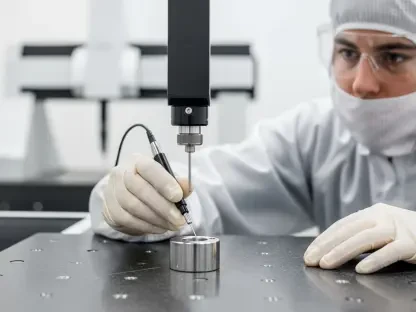In a landscape where over half of the drugs distributed in the United States are produced overseas, the vulnerability of the national pharmaceutical supply chain has become a pressing concern for policymakers and industry leaders alike, especially when imagining a scenario where a sudden geopolitical crisis halts the import of critical medications. This stark reality, which could leave hospitals and patients in dire straits, has propelled the U.S. Food and Drug Administration (FDA) to launch the PreCheck program, a strategic initiative designed to bolster domestic drug manufacturing by easing regulatory hurdles. Unveiled during a pivotal public meeting at the FDA’s White Oak campus in Silver Spring, Maryland, this program aims to reshape the market by incentivizing onshoring. This market analysis delves into the driving forces behind PreCheck, examines current trends and data surrounding domestic production, projects future impacts on the pharmaceutical sector, and offers strategic insights for stakeholders navigating this transformative shift.
Market Drivers: Why Onshoring is Now a National Priority
The U.S. pharmaceutical market has long grappled with a heavy reliance on foreign manufacturing, with a significant portion of active pharmaceutical ingredients (APIs) sourced from just a handful of countries. This dependency, fueled by cost efficiencies and differing regulatory environments abroad, has created a fragile supply chain, exposed by recent global disruptions and international tensions. The FDA’s response through PreCheck aligns with broader governmental mandates, such as executive orders prioritizing domestic production of essential medicines, reflecting a national urgency to safeguard public health and security.
Beyond geopolitical risks, the economic implications of this reliance are substantial. Market data indicates that the cost of supply chain interruptions can lead to billions in losses annually, impacting both manufacturers and healthcare providers. The push for onshoring, therefore, is not merely a regulatory adjustment but a strategic move to mitigate financial risks and ensure consistent access to critical drugs. As the market recalibrates toward domestic production, initiatives like PreCheck are poised to address these systemic vulnerabilities head-on.
This shift also comes amid growing consumer and political demand for transparency and resilience in healthcare supply chains. Stakeholders across the sector recognize that reducing dependence on foreign production could enhance market stability, even if it requires upfront investments and regulatory innovation. The FDA’s proactive stance signals a turning point, setting the stage for a redefined competitive landscape where domestic manufacturing becomes a cornerstone of market strategy.
Current Trends: PreCheck’s Structure and Early Industry Reception
At the core of the PreCheck program lies a two-phase framework designed to streamline the establishment of U.S.-based pharmaceutical facilities. The first phase, focusing on facility readiness, encourages companies to engage early with the FDA during the design and construction of new sites. By submitting detailed quality and design data through specific regulatory filings, manufacturers can address potential issues before they escalate, minimizing delays during final inspections. This trend toward early collaboration marks a departure from traditional, often rigid, regulatory processes, offering a glimpse into a more dynamic interaction between the agency and the industry.
The second phase centers on application submissions, particularly the technical components related to manufacturing processes. Through pre-application meetings, the FDA provides feedback to ensure submissions align with expectations, aiming to reduce inefficiencies and costs associated with bringing facilities online. Industry feedback from the public meeting revealed strong support for this approach, with major pharmaceutical players expressing optimism about the potential to expedite approvals. However, concerns about the FDA’s resource constraints and the scalability of such personalized engagement persist, highlighting a key tension in the current market dynamic.
Market analysis also reveals a broader trend of industry adaptation, as companies begin to explore retrofitted and modular facilities alongside new constructions to meet PreCheck’s criteria. This flexibility in facility types reflects an evolving mindset, where innovation in infrastructure aligns with regulatory incentives. Yet, the challenge of aligning these domestic efforts with global standards, such as those set by European regulatory bodies, remains a critical consideration for multinational firms, shaping how the market responds to PreCheck in its early stages.
Data Insights: Measuring the Scale of Supply Chain Challenges
Quantitative analysis underscores the magnitude of the supply chain issues PreCheck seeks to address. Reports indicate that over 50% of finished drug products and a significant share of APIs consumed in the U.S. are manufactured abroad, creating a dependency that leaves the market exposed to external shocks. Disruptions in even a single key region can lead to shortages of essential medications, with ripple effects felt across healthcare systems and patient outcomes. This data paints a clear picture of why domestic manufacturing has emerged as a strategic imperative.
Further market metrics reveal that the cost of establishing new U.S.-based facilities, while high, could be offset by long-term gains in supply chain reliability. Industry estimates suggest that onshoring initiatives, supported by programs like PreCheck, could reduce the economic impact of drug shortages by up to 30% over the next few years. These figures highlight the potential for regulatory streamlining to not only enhance security but also drive cost efficiencies over time, reshaping investment priorities in the sector.
Drilling deeper, regional disparities in manufacturing capacity add another layer of complexity to the market. Certain states with historical strengths in biopharma are already positioning themselves as hubs for new facilities under PreCheck, potentially creating localized economic booms. However, this uneven distribution raises questions about equitable access to benefits and whether smaller manufacturers can compete in a landscape favoring larger players with greater resources to navigate regulatory pathways.
Future Projections: The Long-Term Impact on Domestic Pharma Markets
Looking ahead, the PreCheck program is expected to catalyze significant shifts in the U.S. pharmaceutical market, with projections indicating a gradual but steady increase in domestic manufacturing capacity over the next few years. Analysts anticipate that by 2027, the share of drugs produced domestically could rise by a notable margin if regulatory incentives and industry adoption align effectively. This growth is likely to be fueled by advancements in modular manufacturing technologies, which allow for faster, more adaptable facility setups under PreCheck’s framework.
Another projection centers on the potential for regulatory evolution, with risk-based inspection protocols and facility certifications independent of specific products emerging as key facilitators. Such changes could lower barriers to entry for smaller firms, fostering a more competitive market environment while maintaining safety standards. The ripple effect might extend globally, positioning the U.S. as a leader in resilient supply chains and inspiring similar initiatives in other regions, thereby influencing international market dynamics.
However, challenges loom on the horizon, particularly around resource allocation and international alignment. The FDA’s ability to scale PreCheck’s personalized engagement model will be critical to its success, as will the harmonization of standards with global partners to avoid dual regulatory burdens for manufacturers. Market forecasts suggest that while immediate, widespread impacts may be limited, the program’s refinement over time could unlock substantial opportunities, redefining investment strategies and operational models in the pharmaceutical sector.
Strategic Reflections and Pathways Forward
Reflecting on the analysis, the rollout of the PreCheck program marks a pivotal moment in addressing the longstanding vulnerabilities of the U.S. pharmaceutical supply chain. It highlights a collective industry and regulatory commitment to onshoring as a means of enhancing national security and market stability. The early enthusiasm from stakeholders, coupled with data-driven insights into the scale of the challenge, underscores the program’s potential to reshape the competitive landscape over time.
For manufacturers, the path forward involves prioritizing early engagement with the FDA to leverage PreCheck’s collaborative framework, thereby mitigating risks during facility development. Investing in scalable, innovative infrastructure like modular setups emerges as a prudent strategy to align with evolving regulatory expectations. Meanwhile, advocating for clearer guidelines and resource support from the agency remains essential to navigating initial implementation hurdles.
Policymakers, on the other hand, face the task of balancing domestic priorities with global coordination, ensuring that PreCheck does not inadvertently create barriers for multinational operations. Addressing resource constraints within the FDA also stands out as a critical next step to maximize the program’s reach. By fostering an environment of innovation and partnership, stakeholders can build on this foundation, paving the way for a more self-reliant and resilient pharmaceutical market in the years that follow.









